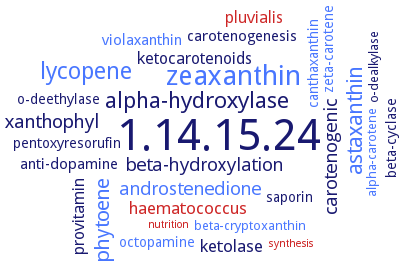1.14.15.24: beta-carotene 3-hydroxylase
This is an abbreviated version!
For detailed information about beta-carotene 3-hydroxylase, go to the full flat file.

Word Map on EC 1.14.15.24 
-
1.14.15.24
-
zeaxanthin
-
lycopene
-
alpha-hydroxylase
-
astaxanthin
-
phytoene
-
xanthophyl
-
carotenogenic
-
androstenedione
-
beta-hydroxylation
-
haematococcus
-
ketolase
-
ketocarotenoids
-
pluvialis
-
provitamin
-
carotenogenesis
-
violaxanthin
-
anti-dopamine
-
pentoxyresorufin
-
saporin
-
canthaxanthin
-
o-deethylase
-
octopamine
-
zeta-carotene
-
beta-cyclase
-
o-dealkylase
-
beta-cryptoxanthin
-
alpha-carotene
-
synthesis
-
nutrition
- 1.14.15.24
- zeaxanthin
- lycopene
-
alpha-hydroxylase
- astaxanthin
- phytoene
-
xanthophyl
-
carotenogenic
- androstenedione
-
beta-hydroxylation
- haematococcus
-
ketolase
-
ketocarotenoids
- pluvialis
-
provitamin
-
carotenogenesis
- violaxanthin
-
anti-dopamine
-
pentoxyresorufin
- saporin
- canthaxanthin
-
o-deethylase
- octopamine
- zeta-carotene
-
beta-cyclase
-
o-dealkylase
- beta-cryptoxanthin
- alpha-carotene
- synthesis
- nutrition
Reaction
Synonyms
AtB1, AtB2, BCH, BCH-type carotene hydroxylase, BCH1, BCH2, beta-carotene (beta,beta-carotene) 3-hydrocylase, beta-carotene 3,3'-hydroxylase, beta-carotene 3-hydroxylase, beta-carotene hydroxylase, beta-carotene hydroxylase 2, beta-carotene oxygenase, beta-hydroxylase, beta-hydroxylase (b1,b2), beta-hydroxylases 1, beta-hydroxylases 2, beta-ring 3(3')-hydroxylase, betaOHase, Bhy, carotene beta hydroxylase 2, carotene ring hydroxylase, carotenoid (beta-ionone ring) 3,3'-hydroxylase, carotenoid 3,(3')-beta-ionone ring hydroxylase, carotenoid 3,3'-hydroxylase, carotenoid beta-ring hydroxylase, carotenoid hydroxylase, carotenoid hydroxylase 2, Chx, CHX1, CHX2, Chy, CHY-beta, CHY1, CHY1/2, CHY2, Chyb, CrtH1, CrtR-B, CrtR-b2, crtRB1, crtS, CrtZ, CrtZ-2, CYP175A1, CYP97A, CYP97a3, CYP97A4, CYP97C1, DSM2, EC 1.14.13.129, HYD, L-carotene hydroxylase, LUT1, LUT5


 results (
results ( results (
results ( top
top





